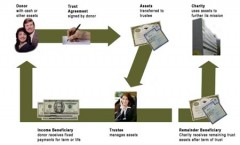A charitable remainder annuity trust (CRAT) is a popular type of life-income plan. Cash, securities, real property, or other assets are transferred into a trust. The trustee manages the trust assets and pays you or others you choose a fixed income for life or for a term of years. When the trust terminates, the remaining assets in the trust are transferred to the Marriott School.
The typical donor:
- Needs income for life or a specified term of years
- Desires a fixed income based on the original value of assets transferred
- Does not plan to make additional gifts to the trust in the future
- Is between the ages of 55 and 80
Gifts features and benefits:
- Income for life (fixed payments)
- Possibility of multiple beneficiaries
- Assets transferred to the trust can be reinvested
- Ability to choose the trustee (may be the donor)
- Investment of assets is designed to balance income needs with preservation of principal
How Do I Make a Gift Using a Charitable Remainder Annuity Trust?

A trust document tailored to your needs is drafted. Your assets are transferred to the trustee you choose. The assets are usually sold by the trustee and reinvested to match your income objectives. You receive fixed income for your life or a specified period of years. At your death or the end of the period, the remaining assets are transferred to the charity of your choice.
Before you begin, you need to make sure your financial and legal advisors are part of your gift strategy team. A charitable remainder annuity trust can have an impact on other parts of your financial and estate plan. The professional staff at LDS Foundation can assist you and your advisors in the creation of trust documents.
Other Facts You Should Know about a Charitable Remainder Annuity Trust
The income tax deduction you receive from a charitable remainder annuity trust is based on an Internal Revenue Service (IRS) formula that considers the ages of the donors and income beneficiaries, the payout of the trust, and an IRS index rate known as the Applicable Federal Rate (AFR). The older you are, the larger your income tax deduction. Generally, if the trust is for a term of years rather than for life, the income tax deduction will be larger. If the present value of the remainder interest equals at least 10 percent of the value of assets transferred into the trust, the trust will qualify as a charitable remainder annuity trust. Also, a federally imposed 5 percent probability test determines the viability of the trust assets supporting the annuity payments. To qualify, the trust provision must meet this test.
The trust provisions you have control of when drafting your charitable remainder annuity trust include:
- Choosing a trustee
- Designating the income beneficiaries
- Naming the charitable remainder beneficiaries
- Deciding on a payout rate for the trust
- Determining the frequency of the payments
- Selecting the term of the trust
With a charitable remainder annuity trust, certain activities associated known as “self-dealing” are prohibited. Self-dealing rules prevent a donor who has transferred property to a trust, or a donor’s family, from dealing with the trust. Actions considered to be “dealing” include buying from, selling to, and renting from the trust, and continuing to do business with the trust. The donor, the trustee, members of their families, and entities such as corporations in which they have substantial interests are “disqualified persons” and are prohibited from dealing with a trust that has been a recipient of the donor’s property.
Charitable remainder annuity trusts use a tier system in determining the taxation of trust income to income beneficiaries. Whether or not all income produced by the trust is distributed to the income beneficiary, the trust pays no income taxes on its earnings as long as it has no unrelated business taxable income (UBTI). An example of UBTI would be debt-financed income. The income to the income beneficiary from the trust is taxed based on the historical pattern of how income in the trust was earned. Income distributions are taxed in the following order:
- Ordinary income
- Capital gain income
- Tax-free income
- Return of principal (corpus)
For example, suppose you transferred a piece of real estate to the trust then sold the real estate and reinvested in blue-chip stock that provided both dividend income and capital growth. As income is paid from the trust to you, you would report all income as ordinary income (tier 1) to the extent of all dividend income received into the trust. Only after recognizing all ordinary income would you then report capital gain income (tier 2) from the sale of the real estate. As a general rule, you should assume for planning purposes that trust income will be taxed as ordinary income.





 BYU Marriott
BYU Marriott